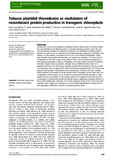Mostrar el registro sencillo del ítem
Tobacco plastidial thioredoxins as modulators of recombinant protein production in transgenic chloroplasts
| dc.creator | Sanz Barrio, Ruth | es_ES |
| dc.creator | Fernández San Millán, Alicia | es_ES |
| dc.creator | Corral-Martínez, Patricia | es_ES |
| dc.creator | Seguí-Simarro, José M. | es_ES |
| dc.creator | Farrán Blanch, Inmaculada | es_ES |
| dc.date.accessioned | 2019-01-16T08:07:59Z | |
| dc.date.available | 2019-01-16T08:07:59Z | |
| dc.date.issued | 2011 | |
| dc.identifier.issn | 1467-7644 (Print) | |
| dc.identifier.issn | 1467-7652 (Electronic) | |
| dc.identifier.uri | https://hdl.handle.net/2454/31983 | |
| dc.description.abstract | Thioredoxins (Trxs) are small ubiquitous disulphide proteins widely known to enhance expression and solubility of recombinant proteins in microbial expression systems. Given the common evolutionary heritage of chloroplasts and bacteria, we attempted to analyse whether plastid Trxs could also act as modulators of recombinant protein expression in transgenic chloroplasts. For that purpose, two tobacco Trxs (m and f) with different phylogenetic origins were assessed. Using plastid transformation, we assayed two strategies: the fusion and the co‐expression of Trxs with human serum albumin (HSA), which was previously observed to form large protein bodies in tobacco chloroplasts. Our results indicate that both Trxs behave similarly as regards HSA accumulation, although they act differently when fused or co‐expressed with HSA. Trxs–HSA fusions markedly increased the final yield of HSA (up to 26% of total protein) when compared with control lines that only expressed HSA; this increase was mainly caused by higher HSA stability of the fused proteins. However, the fusion strategy failed to prevent the formation of protein bodies within chloroplasts. On the other hand, the co‐expression constructs gave rise to an absence of large protein bodies although no more soluble HSA was accumulated. In these plants, electron micrographs showed HSA and Trxs co‐localization in small protein bodies with fibrillar texture, suggesting a possible influence of Trxs on HSA solubilization. Moreover, the in vitro chaperone activity of Trx m and f was demonstrated, which supports the hypothesis of a direct relationship between Trx presence and HSA aggregates solubilization in plants co‐expressing both proteins. | en |
| dc.description.sponsorship | This work was supported by grants Res.17/2004 and IIM10865.RI1 (Proyecto EUROINNOVA) from Gobierno de Navarra (Spain). RSB and PCM were supported by predoctoral fellowships from CSIC and Generalitat Valenciana, respectively. | en |
| dc.format.extent | 12 p. | |
| dc.format.mimetype | application/pdf | en |
| dc.language.iso | eng | en |
| dc.publisher | Wiley | en |
| dc.relation.ispartof | Plant Biotechnology Journal (2011) 9, pp. 639–650 | en |
| dc.rights | © 2011 The Authors | en |
| dc.subject | Thioredoxin | en |
| dc.subject | Plastid trans-formation | en |
| dc.subject | Human serum albumin | en |
| dc.subject | Tobacco | en |
| dc.title | Tobacco plastidial thioredoxins as modulators of recombinant protein production in transgenic chloroplasts | en |
| dc.type | info:eu-repo/semantics/article | en |
| dc.type | Artículo / Artikulua | es |
| dc.contributor.department | IdAB. Instituto de Agrobiotecnología / Agrobioteknologiako Institutua | es |
| dc.rights.accessRights | info:eu-repo/semantics/openAccess | en |
| dc.rights.accessRights | Acceso abierto / Sarbide irekia | es |
| dc.identifier.doi | 10.1111/j.1467-7652.2011.00608.x | |
| dc.relation.publisherversion | https://doi.org/10.1111/j.1467-7652.2011.00608.x | |
| dc.type.version | info:eu-repo/semantics/publishedVersion | en |
| dc.type.version | Versión publicada / Argitaratu den bertsioa | es |
| dc.contributor.funder | Gobierno de Navarra / Nafarroako Gobernua, Res.17/2004 and IIM10865.RI1 | es |


